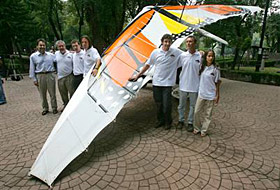 |
 |
 |
 News from Around the Americas | August 2005 News from Around the Americas | August 2005  
Humans to Join Canada-Mexico Butterfly Trek
 Associated Press Associated Press


| | This motorized glider will be used to track monarch butterflies as they start migrating in mid-August from Canada to Mexico. Vico Gutierrez, second from left, helped jump start the project. He was joined by assistants and sponsors at a presentation Wednesday in a Mexico City park. (Photo: Dario Lopez-Mills/AP) |
The annual arrival of millions of Monarch butterflies from the forests of eastern Canada to the central Mexican mountains for the winter is an aesthetic and scientific wonder. And this year, they won’t be flying alone.

A crew of two plans to accompany the butterflies on their 3,415 mile-journey while riding in an oversized hang-glider painted with giant versions of the orange, black and white wings of the Monarch.

Their aim is to raise awareness about the need to better conserve the Monarchs’ fragile habitats. Illegal logging is thinning and toppling the fir forests west of Mexico City that protect the butterflies from rain and cold.

Mexican pilot Francisco “Vico” Gutierrez and a crew including other pilots from Canada, the United States and Mexico plan to leave Quebec on Aug. 15 for the trip. The journey should produce a documentary, and a photographer or cameraman will accompany Gutierrez or other pilots on board, while the rest of the team follows in a van.

N.Y. City, Washington stops

“I’m really content, really excited,” said Gutierrez, watching as crew members assembled the 400-pound, 34-by-8-foot plane in a crowded park in Mexico City.

The ultra-light plane, which will be propelled by a tiny motor, will track every part of the winter migration. The route will take them to Montreal and Toronto in Canada and south across the United States with stops at Niagara Falls, N.Y.; New York City; Washington D.C.; Lawrence, Kan.; Oklahoma City; Austin, Texas; and Eagle Pass on the Mexican border.

The trip is scheduled to an end on Nov. 2, in Valle Del Bravo, close to the forests where the butterflies winter in Michoacan state. It is sponsored by the World Wildlife Fund of Mexico, the government of Michoacan and Gutierrez himself.

The project is dubbed Papalotzin, a word from the ancient Nahuatl language spoken by the Aztecs that roughly translates to small butterfly.

Butterflies average 12 mph

The aircraft is equipped with a small 80-horsepower engine. That is more than enough to keep up with the butterflies, who travel between 60 and 95 miles daily at average speeds of 12 mph before landing to rest, Gutierrez said.

He plans to pilot the plane about five times faster than the rate of the butterflies, but only travel the daily distances they travel.

Carlos Galindo, forest director for the World Wildlife Fund in Mexico, said no one has followed the butterflies in the air for their entire transcontinental journey. Doing so can teach scientists how they cope with changing wind patterns, temperature shifts and difficult weather, he said.

It is also unclear, for instance, at what altitude the butterflies cruise and why those migrating have a life span of eight months while generations that come before and after the trip live only about a month, he said. But that knowledge is not the primary goal of the mission.

“The object of this trip is not a scientific one, it’s a trip aimed to increase awareness,” Galindo said. | 
 | |
 |



